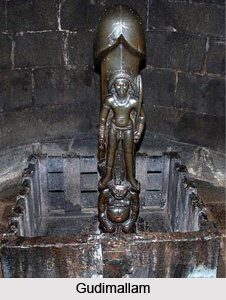 Gudimallam is an Indian village based in Srikalahasti Mandal, Chittoor District in the southern Indian state of Andhra Pradesh. It is present at a distance of nearly seven miles from the Renigunta Railway Junction. Despite being a small village, Gudimallam is of historical significance due to the existence of a renowned Lord Shiva temple which is referred to as the `Parasurameswara Temple`.
Gudimallam is an Indian village based in Srikalahasti Mandal, Chittoor District in the southern Indian state of Andhra Pradesh. It is present at a distance of nearly seven miles from the Renigunta Railway Junction. Despite being a small village, Gudimallam is of historical significance due to the existence of a renowned Lord Shiva temple which is referred to as the `Parasurameswara Temple`.
Architecture of Gudimallam
The main temple comprises of an apsidal shrine in a low level with the "Mahamanapada" and "Ardha Manapada" in front, all of them facing east and each of them is higher than the other chronologically. The main entrance towards the shrine is from south of the Maha Manapada. A walled enclosure is added by an ornamental porch pillared known as "Dwarapala." A peristyler cloister closes the main shrine all round externally. Over the shrine, there is the Vimana which is hallowed inside and apsidal on plan. It is in elevation with a resemblance of a linga and hence, known as "Lingakruthi Vimana." There is a false ceiling on the sanctum over wooden joints. The temple complex of stone in the late "Bana/ Pallava" and "Chola" style with good number of inscribed records speak of forever gifts made by the kings. The earliest part belongs to the "Banas" and the latest one belongs to the "Yadava Devaraya" time. The inscriptions of Vikrama Chola"s time refer to completely rebuilding of the temple.
Lingas of Gudimallam
The `Linga` present in the premises of this temple is quite famous and it has been placed in the `garbhagriha` of this temple. It is believed that this very Linga is one of the most ancient Shiva Lingas discovered till date and it belongs to the period of the 2nd or the 1st century BC.
This Shiva Linga is made from a hard, dark brown stone which measures 5 feet in height and one foot in thickness. A unique two-armed image of Lord Shiva has been engraved on the Shiva Linga, in the `sthanaka` posture. The Linga contains a prominent slanted groove designed on top of it, and the front part of the Linga, the God is depicted as standing over the shoulders of the `apasmarapurusha`. A tiny vessel is held in the left hand of the deity while his right hand holds a ram. A `Parasu` or battle axe rests over his left shoulder and his head is adorned with `Jatas`, inspired by the style of `Jatabhara`. Numerous rings hang from his ears, as well as a girdle armed with a dangling central part.
One will notice a `dhoti` which covers the image of the God from below his waist which has been fastened with the aide of a unique `vastra-mekhala` and the deity lacks a proper `Yagnopavita`. Copper coins found here belong to the 3rd century. The Gudimallam Shiva Linga as well as the Shiva Lingas belonging to the Gupta Age and also the Shiva Lingas of the pre-Gupta periods do not display the characterization of the `pita` or `arghya`. Excavations conducted by the Archaeological Survey of India indicate the presence of a pedestal at the base of Gudimallam Linga.
Inscriptions of Gudimallam
The inscriptions embedded on the walls of the temple suggest that this temple is termed Parasurameshwara Temple. However these inscriptions do not shed any light regarding the original creators of the temple. Some excavations conducted during 1973 have unearthed Redware and black sherds of the 3rd or 2nd century AD as well as large bricks and potsherds which belong to the era of the Satavahana Dynasty who ruled over Andhra Pradesh probably from the 1st century circa to 2nd century AD.
Many of the local inscriptions have claimed that this region can be dated back to the Ganga Pallavas, Pallavas, Chola Dynasty and Bana Dynasty. These inscriptions have been discovered on the inner walls of the Parasurameshwara Temple and also over stone slabs in the courtyard of the temple. The oldest inscription can be traced back to the regime of Nandivarma Pallava belonging to 802 AD. The most astonishing fact is that not a single inscription refers to the present name of this village, Gudimallam. The floor of the sanctum sanctorum is present much below the floor levels of Mukhamantapa and Antarala. The image of Lord Shiva carved out signifies a fierce hunter. This village is also referred to as `Viprapita` or `Brahmana Agrahara`.



















